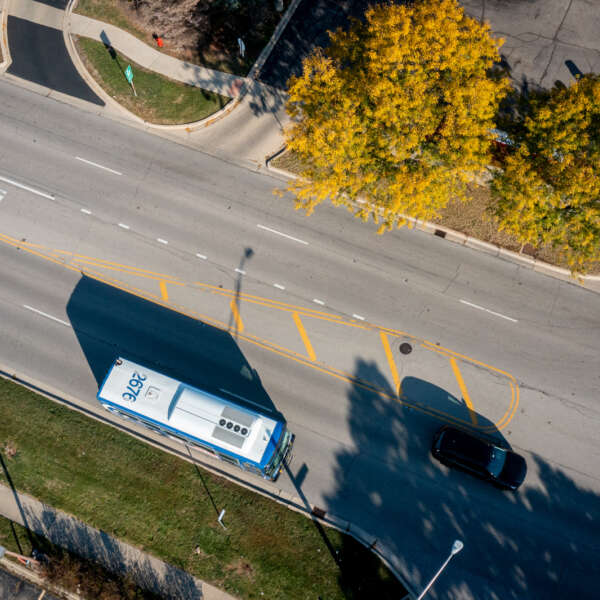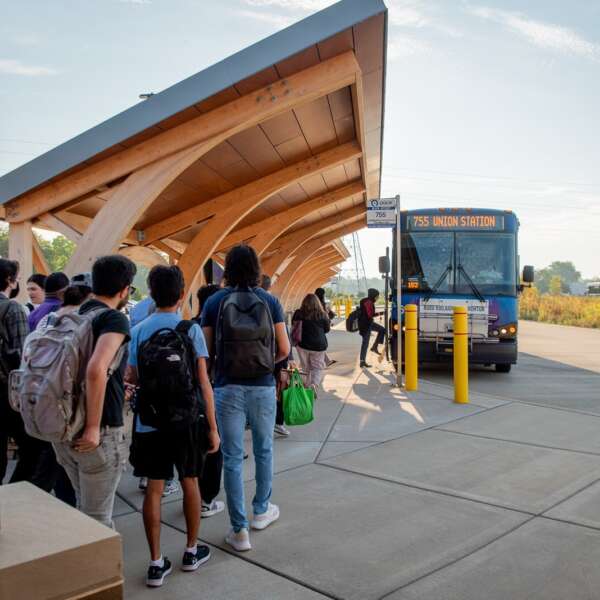How peer states are addressing their transit systems’ fiscal cliffs
September 11, 2024
September 11, 2024

Public transit plays an essential role in the lives of millions of riders across the Chicago region and has the potential to reach even more people, but the system has been drastically underfunded for decades. This lack of funding has been exacerbated in recent years because of pandemic-induced drops in ridership and the growth of remote work.
Today, ridership is recovering, but this momentum is at risk if the system doesn’t secure increased operating funding. Beginning in 2026 the RTA system will face a projected $730 million annual budget gap—nearly 20% of the regional operating budget. Without new funding, agencies will be forced to implement service cuts of up to 40% and dramatic fare increases.
Our region is not alone in facing these challenges; large transit systems across the nation are facing proportionately similar funding gaps. While Illinois has yet to act on the Chicago region’s fiscal cliff, to date, six states have taken action to provide additional funding to transit.
Many states have taken action to address the fiscal cliff for their transit systems ranging from temporary, one-time funding to identifying new sources of sustainable revenue for the future.
The RTA system is projected to run out of federal relief funding by 2026, but many other states were confronted with fiscal cliffs sooner. These accelerated schedules forced states to grapple with how to sustain transit operations amidst other competing priorities. For many, this led to one-time bridge funding that buys more time to consider other sustainable revenue options. While the RTA system’s fiscal challenges remain urgent, Illinois can be thoughtful and comprehensive in addressing the new revenues and reforms needed to improve the transit system long-term.
The State of California acted in 2023 to address their transit systems’ fiscal cliffs and buy some time until a long-term fix can be found, but the state’s plan leaves systemic funding challenges unmet. The plan relies on temporarily flexing capital dollars for operations, which diverts funding from state of good repair needs. It also includes $1.1 billion in cap-and-trade revenue that can be used for both operations and capital expenses. Individual transit systems are exploring local funding solutions to supplement this state funding patch, including San Francisco’s Bay Area Rapid Transit (BART), which is seeking legislative action to authorize a referendum creating a payroll and a parcel tax, estimated to generate $1.5 billion annually. San Francisco voters will also decide on another referendum this November that would levy a per-ride tax on certain ridesharing and autonomous vehicle companies, estimated to generate $25 million annually to support the city’s Municipal Transportation Agency (Muni).
This year, Pennsylvania authorized $51 million in state assistance to the Southeastern Pennsylvania Public Transportation Authority (SEPTA)—only 1/3 of the amount in the governor’s proposed budget and about 20% of the system’s projected $240 million annual deficit. This funding is linked to increases in local contributions from the counties SEPTA serves and delayed the agency’s projected fiscal cliff by about one year. SEPTA has proposed incremental fare increases every three years starting in 2026 to help address its long-term needs, but additional public investment will be needed to avoid further service cuts and fare increases.
Washington, D.C., Maryland, and Virginia modestly increased their annual contributions to the Washington Metro Area Transit Authority (WMATA) as a short-term solution. Falling short of the agency’s budget needs, WMATA was forced to implement fare hikes of 12.5% across the board and up to 25% on late-night service this year. These fare increases and one-time state assistance temporarily prevented a 50% systemwide service cut, but future action is needed to prevent cuts and additional fare hikes.
New York’s Metropolitan Transportation Authority (MTA) received $4.5 billion in combined one-time and ongoing funding in 2023, pushing its fiscal cliff to 2027. Ongoing, sustainable revenue from this package included an increase to the state’s payroll tax—generating $1.1 billion annually—and a new casino tax, which is expected to generate $231-413 million annually starting in 2026. New York was set to implement a first-in-the-nation congestion pricing policy to fund capital improvements, which would bring in $1 billion in annual revenue and incentivize transit use; however, Gov. Kathy Hochul paused the plan in June 2024. The MTA subsequently adjusted their ridership and fare revenue estimates to account for the pause, which have resulted in revised projections showing an operating budget gap of up to $400 million occurring by 2027.
This year, New Jersey will raise an estimated $1 billion in sustainable revenue through a progressive Corporate Transit Fee— a 2.5% corporate business tax on companies with a taxable income of more than $10 million. The fee is charged on top of the existing, annual corporate business tax and is dedicated to supporting New Jersey Transit. The fee is imposed for only five years, however, and will sunset in State Fiscal Year 2029. New Jersey Transit increased fares by 15% and will continue to do so by 3% each year in anticipation of the sunset.
Perhaps the most comprehensive transit funding package yet, Minnesota passed legislation in 2023 that creates a regional transportation sales tax and a retail delivery fee, which combined are projected to raise as much as $700 million annually for capital and operations. The package also indexes the state’s gas tax to inflation, providing further sustainable funding to continue to meet Metro Transit’s needs in the future. With the additional revenue, Minnesota was also able to increase transit service levels and fund a $200 million expansion of passenger rail, which will connect Minneapolis/St. Paul and Duluth.
Without new, sustainable sources of revenue to support transit, CTA, Metra, and Pace will be forced to consider drastic service cuts and fare increases—both of which would reduce ridership and grow revenue shortfalls, placing the transit system in a death spiral. Beyond service, the region would experience a serious blow to its economic vitality, quality of life, and environmental wellbeing. Riders without other transportation options would be left behind, losing access to jobs, education, and health care.
Solutions to transit's funding challenges should prepare the Service Boards to plan for 2050 and beyond. Sustainable investment in the region’s transit system would help to grow ridership and increase revenue, which would facilitate these service improvements over time. The region’s transit strategic plan, Transit is the Answer, offers a slate of revenue options that could meet the needs of riders well into the future.
The RTA is working with policy makers at all levels of government to develop sustainable funding solutions and improve the system for all riders. Join the Transit is the Answer Coalition to help bring about the legislative changes needed to support transit at this pivotal moment.
Subscribe to our Newsletter
Related Articles
 Coalition members provide feedback on ‘Transforming Transit,’ RTA’s vision for improved service and accountability
Coalition members provide feedback on ‘Transforming Transit,’ RTA’s vision for improved service and accountability
Nearly 200 riders, advocates, and other stakeholders met virtually with the RTA on February 11 for the sixth quarterly Transit is the Answer Coalition meetin...
February 20, 2025 Far South Halsted Corridor Study prepares for future Pace Pulse service
Far South Halsted Corridor Study prepares for future Pace Pulse service
An RTA Community Planning project kicked off in late 2023 as a crucial step in bringing Pace Pulse service to Chicago’s south suburbs. The Far South Halsted ...
February 19, 2025 RTA proposes reforms to prioritize capital projects, maximizing impact of funding
RTA proposes reforms to prioritize capital projects, maximizing impact of funding
RTA is proposing a historic restructuring of the region’s transit governance to maximize the impact of new operating funding and ensure all riders experience...
February 5, 2025 RTA proposes reforms to integrate fares, require accountability for faster and more reliable transit
RTA proposes reforms to integrate fares, require accountability for faster and more reliable transit
RTA is proposing a historic restructuring of the region’s transit governance to maximize the impact of any new operating funding and ensure all riders experi...
February 5, 2025 For the third year in a row, regional transit ridership was up by double-digits in 2024
For the third year in a row, regional transit ridership was up by double-digits in 2024
Ridership across the Chicago region’s transit system continued to increase throughout 2024, according to the latest data from CTA, Metra, and Pace. The regio...
January 28, 2025 RTA is seeking $1.5 billion in annual operating funding. What would that mean for your commute?
RTA is seeking $1.5 billion in annual operating funding. What would that mean for your commute?
On January 15, RTA released Transforming Transit, a vision for the regional transit system with $1.5 billion in annual operating funding supported by a stron...
January 28, 2025